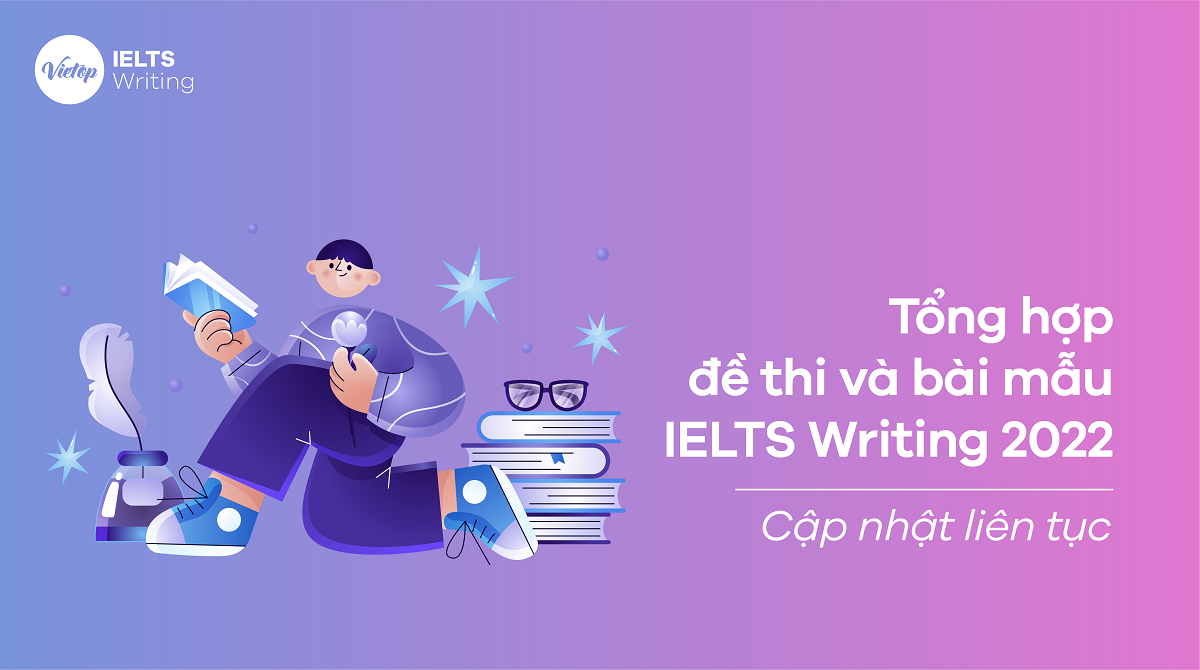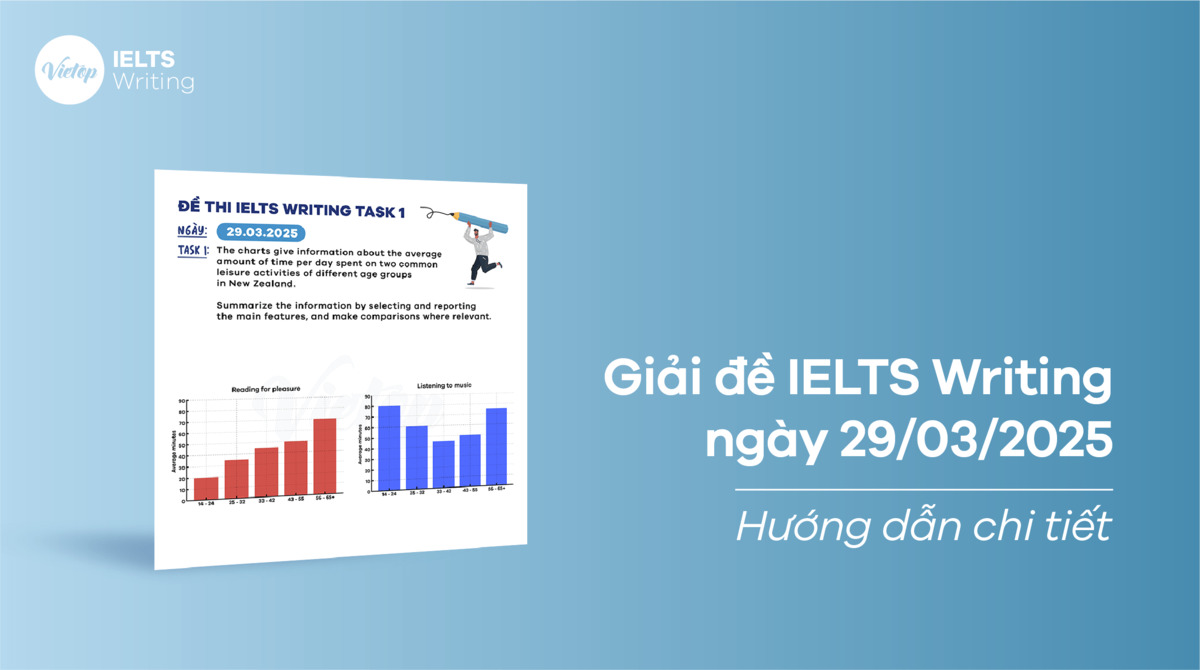Vietop gửi bạn giải đề IELTS Writing ngày 16/12/2023 bên dưới nhé! Các bạn theo dõi và ôn luyện IELTS Writing thật tốt nhé!
IELTS Writing task 1
The graph below shows the percentages of tourists who used different types of transport to travel within a particular nation between 1989 and 2009. Each tourist may have used more than one type of transport.
![[ACE THE TEST] Giải đề IELTS Writing ngày 16122023](https://vietop.edu.vn/wp-content/uploads/2023/12/ACE-THE-TEST-Giai-de-IELTS-Writing-ngay-16122023.png)
Bước 1: Lập dàn ý
Đoạn tổng quan: Tổng thể, có một số lượng người du lịch tăng lên sử dụng mọi phương tiện giao thông để đi lại trong quốc gia, ngoại trừ việc sử dụng máy bay đã giảm suốt thời kỳ.
Ngoài ra, người sử dụng tàu hỏa trải qua sự tăng trưởng đáng chú ý nhất để vượt qua người sử dụng ô tô và chiếm ưu thế trên biểu đồ vào cuối kỳ, trong khi tàu phà vẫn duy trì tỷ lệ thấp nhất.
| Thân bài 1 | Thân bài 2 |
| Phần trăm người du lịch lựa chọn phương tiện tàu hỏa tăng lên một cách đáng kể nhất, tăng lên từ vị trí thứ ba ban đầu (khoảng 35%) và cuối cùng vượt qua ô tô để trở thành phương tiện di chuyển phổ biến nhất vào năm 2009, khi gần 60% số họ sử dụng loại này. Xe buýt gần như chính xác mô phỏng mô hình tăng trưởng của tàu hỏa, tuy nhiên ở mức thấp hơn, tăng từ dưới 10% lên khoảng 25% suốt thời kỳ. Những xu hướng tăng này đối lập với người du lịch đi máy bay, tỷ lệ của họ giảm gần một nửa, từ 40% đến chỉ còn 20% vào năm cuối cùng. | Con số cho những người lái ô tô, mặc dù tăng lên đạt đỉnh vào năm 1999 một cách nhẹ nhàng vượt trên 60%, nhưng giảm ổn định xuống còn khoảng 50% vào năm 2009. Mặc dù có sự giảm này, trong phần lớn thời kỳ, ô tô vẫn là phương tiện phổ biến nhất được sử dụng để đi lại trong đất nước bởi du khách, trừ trong ba năm cuối cùng. Ngược lại, tàu phà luôn được sử dụng ít nhất, với tỷ lệ tăng dần đến mức cao nhất vào năm 2004 trước khi giảm nhẹ xuống khoảng 9% vào cuối thời kỳ. |
Bước 2: Hoàn thành bài luận
The line graph gives information about the proportion of domestic visitors who travelled in one unspecified nation using five various means of transport from 1989 to 2009.
Overall, there was an increasing number of tourists who used all modes of transport to travel within the nation, with the exception of air usage which saw a decline throughout. Additionally, train users underwent the most noticeable growth to overtake car ones and dominate the graph at the end of the period, while ferries still remained the lowest.
The percentage of travellers opting for railway transportation increased the most significantly, growing from the third highest initially (around 35%) and eventually surpassing cars to become the most commonly used means of transport in 2009, when just under 60% of them travelled by this type.
Coach almost exactly mirrored rail’s growing pattern, albeit at a far lower rate, going up from slightly under 10% to approximately 25% over the period. These rising trends are in contrast to tourists travelling by plane, whose proportion nearly halved, declining from a significant 40% to only 20% in the final year.
The figure for those driving by cars, despite increasing to reach a peak of marginally above 60% in 1999, saw a steady drop to roughly 50% in 2009. Although there was such a fall, for the majority of the period, cars still generally remained the most prevalent type of vehicle used to travel around the country by tourists, except for the final three years.
Conversely, ferry was consistently used the least, with its percentage rising gradually to its high of just above 10% in 2004 before experiencing a minimal drop to around 9% at the end of the time frame.
Bạn muốn phân tích và triển khai ý tưởng logic khi làm dạng bài line chart? Thông qua việc tham khảo bài mẫu về cách phân tích và lập luận sẽ giúp bạn xây dựng tư duy luyện thi và giải đề nhanh, chính xác. Tại khoá học IELTS 6.0 của Vietop English giúp bạn làm chủ tất cả dạng câu hỏi và kỹ năng viết theo yêu cầu. Cùng Vietop xây dựng lộ trình học phù hợp, giúp bạn rút ngắn thời gian đạt điểm IELTS mục tiêu.
Bước 3: Cấu trúc ngữ pháp
The percentage of travellers opting for railway transportation increased the most significantly. It grew from the third highest initially (around 35%) and eventually surpassing …
→ The percentage of travellers opting for railway transportation increased the most significantly, growing from the third highest initially (around 35%) and eventually surpassing …
Xem thêm:
- [ACE THE TEST] Giải đề IELTS Writing ngày 07/12/2023
- [ACE THE TEST] Giải đề IELTS Writing ngày 02/12/2023
- [ACE THE TEST] Giải đề IELTS Writing ngày 25/11/2023
IELTS Writing task 2
People living in the twenty-first century have a better quality of life than people who live in previous centuries. To what extent do you agree or disagree?
Bước 1: Phân tích đề
- Từ khoá: twenty-first century, a better quality of life
- Câu hỏi: Đề bài yêu cầu thí sinh đưa ra quan điểm đồng tình/ không đồng tình với nhận định rằng chất lượng cuộc sống thế kỉ 21 tốt hơn so với các thế kỉ trước. Ở đây Vietop theo hướng cân bằng, vừa đồng tình cũng vừa phản đổi nhé.
Bước 2: Lập kế hoạch cho bài luận
| Thân bài 1 | Thân bài 2 |
| 1. Topic Sentence: Major advancements in healthcare and technology have significantly improved the quality of life in the twenty-first century. 2. Supporting Ideas: – Breakthroughs in medical fields provide better healthcare services and treatment options, leading to increased life expectancy and eradication of fatal diseases. – Technology has transformed communication, enhancing social bonds and emotional well-being. – Life convenience is improved through online shopping and smart home devices, allowing people to focus on more meaningful activities and contributing to overall comfort. | 1. Topic Sentence: Despite progress, the twenty-first century presents unique difficulties and inequalities that impact overall quality of life. 2. Supporting Ideas: – Wealth disparity affects access to medical services, particularly for underprivileged groups. – Technology contributes to social isolation and the lack of depth in relationships, as individuals become increasingly addicted to virtual interactions. – Job displacement and economic uncertainty resulting from automation and artificial intelligence impact individuals’ overall quality of life. |
Bước 3: Hoàn thành bài luận
In comparison to individuals residing in earlier centuries, those living in the twenty-first century experience an improved standard of living. While acknowledging the reason for this school of thought, I believe that it is unwise to make such a sweeping generalization.
On the one hand, it is true that given major advancements in healthcare and technological developments, the quality of life has significantly improved in the twenty-first century. With regard to the former factor, breakthroughs in medical fields have given citizens access to better healthcare services and treatment options, the results of which would be an increase in life expectancy and eradication of certain fatal diseases that once posed significant threats or even claimed many lives.
In terms of the latter, technology has led to a complete transformation in terms of communication, when people can stay connected with friends and family regardless of geographical barriers, enhancing social bonds and emotional well-being.
The impacts of technology extend beyond those on communication, as life convenience is also made possible thanks to online shopping or smart home devices that eliminate repetitive daily tasks, allow people to focus on more meaningful activities and thus contribute to the overall sense of comfort.
On the one hand, It is critical to recognize that the twenty-first century presents unique difficulties and inequalities that affect people’s quality of life as a whole. Firstly, despite much progress in medicine and healthcare, there is the issue of wealth disparity to be taken into account.
In other words, not every individual in society, especially those who come from underprivileged groups, have access to medical services, which are more often than not beyond their budget. Secondly, the prevalence of technology has also given rise to a host of worrying issues, the first of which is increasing feelings of social isolation and lack of quality and depth of relationship.
This stems from the fact that many online users are becoming increasingly addicted to their mobile devices and tend to take more interest in establishing virtual relationships. Moreover, the fear of job displacement and economic uncertainty brought about by automation and artificial intelligence are other causes for concern, affecting individuals’ overall quality of life.
In conclusion, while the assertion that people living in the twenty-first century experience a better quality of life than their predecessors is reasonable to a certain extent, as a result of the developments of healthcare and technology, it is crucial to acknowledge the fact that modern life comes with its own set of challenges and disparities that impact the overall quality of life.
Bước 4: Từ vựng
| Vocabulary | Meaning in Vietnamese |
| Breakthrough | Bước đột phá, sự tiến bộ đột ngột |
| Eradication | Sự tiêu diệt, loại bỏ hoàn toàn |
| Social Bonds | Mối liên kết xã hội |
| Wealth Disparity | Chênh lệch về giàu có giữa các tầng lớp xã hội |
| Job Displacement | Mất việc làm, sự chuyển đổi trong việc làm |
Gap-fill Exercise:
- 1. The __________ in medical research led to the discovery of a new treatment for the disease.
- Answer: Breakthrough
- 2. The government aims for the __________ of poverty in the country through various social programs.
- Answer: Eradication
- 3. Meaningful relationships and connections contribute to strong __________ within a community.
- Answer: Social Bonds
- 4. The widening __________ between the rich and the poor is a pressing issue in many societies.
- Answer: Wealth Disparity
- 5. Automation and artificial intelligence can result in __________, causing concerns about unemployment.
- Answer: Job Displacement
Xem ngay: Tổng hợp đề thi IELTS Writing 2023 kèm bài mẫu chi tiết
Hy vọng bài giải đề IELTS Writing ngày 16/12/2023 đã cung cấp thêm cho bạn nhiều từ vựng, cấu trúc và ý tưởng để vận dụng cho bài viết của mình khi luyện thi IELTS. Chúc bạn thi IELTS tốt!
Ngoài ra, các bạn cần phải thường xuyên cập nhập lịch thi IELTS để có kế hoạch ôn thi IELTS phù hợp nhé!


![[ACE THE TEST] Giải đề IELTS Writing ngày 07/04/2025](https://vietop.edu.vn/wp-content/uploads/2025/04/giai-de-ielts-writing-ngay-07-04-2025.png)

![[ACE THE TEST] Giải đề IELTS Writing ngày 15/03/2025](https://vietop.edu.vn/wp-content/uploads/2025/03/giai-de-ielts-writing-ngay-15-03-2025.jpg)
![[ACE THE TEST] Giải đề IELTS Writing ngày 22/03/2025](https://vietop.edu.vn/wp-content/uploads/2025/03/giai-de-ielts-writing-ngay-22-03-2025.jpg)
![[ACE THE TEST] Giải đề IELTS Writing ngày 08/03/2025](https://vietop.edu.vn/wp-content/uploads/2025/03/giai-de-ielts-writing-ngay-08-03-2025.jpg)
![[ACE THE TEST] Giải đề IELTS Writing ngày 06/03/2025](https://vietop.edu.vn/wp-content/uploads/2025/03/giai-de-ielts-writing-ngay-06-03-2025.jpg)
![[ACE THE TEST] Giải đề IELTS Writing ngày 22/02/2025](https://vietop.edu.vn/wp-content/uploads/2025/02/giai-de-ielts-writing-ngay-22-02-2025.jpg)
